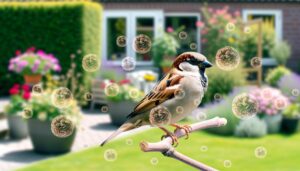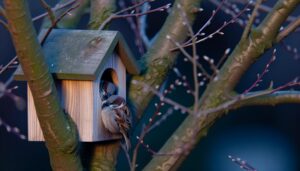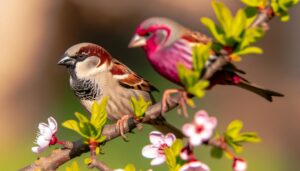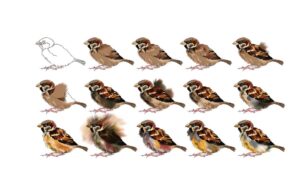House Sparrow vs Song Sparrow: 5 Key Differences
House Sparrows (Passer domesticus) are robust with a stocky build and gray-brown coloration, while Song Sparrows (Melospiza melodia) are slender and boast streaked brown and rust plumage. House Sparrows prefer urban and suburban environments, synanthropic by nature, whereas Song Sparrows thrive in open, shrubby areas and wetlands.
The diets also differ: House Sparrows are omnivorous ground feeders, while Song Sparrows consume a variety of insects, seeds, and fruits at ground and shrub levels. Breeding behaviors vary, with House Sparrows opting for human-made structures and Song Sparrows for dense vegetation.
Their vocalizations range from simple chirps to complex songs. Exploring their behaviors and interactions can reveal much more.

Key Takeaways
- House Sparrows have a robust build and grayish-brown coloration, while Song Sparrows are slender with intricate streaks of brown and rust.
- House Sparrows thrive in urban areas, whereas Song Sparrows prefer open, shrubby environments and wetlands.
- House Sparrows are omnivorous and ground-feeding; Song Sparrows have a varied diet and feed at ground and shrub levels.
- House Sparrows nest in human-made structures; Song Sparrows choose dense vegetation and low shrubs for nesting.
- House Sparrows produce simple chirps; Song Sparrows have complex, melodious songs for territorial and social interactions.
Physical Appearance
The physical appearance of the House Sparrow (Passer domesticus) and the Song Sparrow (Melospiza melodia) differs noticeably, with the former exhibiting a more robust, stocky build and the latter characterized by its slender frame and streaked plumage. House Sparrows possess a stout bill, ideal for cracking seeds, and display a mostly grayish-brown coloration with bold black markings on the throat and chest.
Conversely, Song Sparrows are noted for their intricate streaks of brown and rust across a white or grayish background, with a distinctive central breast spot. Their conical bills are slightly more delicate, suited for a varied diet. Both species exhibit sexual dimorphism, with males typically more vividly colored than females, aiding in species-specific identification.
Habitat Preference
Habitat preference for House Sparrows and Song Sparrows varies significantly, with House Sparrows frequently inhabiting urban and suburban areas, while Song Sparrows are more commonly found in open, shrubby environments and wetlands.
House Sparrows (Passer domesticus) exhibit a strong affinity for human-altered landscapes, capitalizing on structures for nesting and abundant food sources. Their adaptability to densely populated areas underscores their synanthropic nature.
In contrast, Song Sparrows (Melospiza melodia) are typically associated with more natural, heterogeneous habitats, favoring riparian zones, marshes, and thickets. Their presence is often indicative of ecotonal regions, where vegetation density provides optimal conditions for foraging and nesting.
Understanding these habitat preferences is essential for conservation efforts and habitat management strategies aimed at supporting both species.
Feeding Habits
While both House Sparrows and Song Sparrows exhibit omnivorous feeding behaviors, their dietary preferences and foraging techniques reveal significant ecological adaptations.
House Sparrows (Passer domesticus) primarily consume seeds and grains, often frequenting urban areas where they exploit anthropogenic food sources. They exhibit ground-feeding behaviors, showing resilience in diverse habitats.
Conversely, Song Sparrows (Melospiza melodia) display a more varied diet, including insects, seeds, and fruits, reflecting their adaptability to different ecosystems. Their foraging strategy is more versatile, involving both ground and shrub-level feeding. This ecological flexibility enhances their survival in both rural and suburban landscapes.
Observational studies note differences in their feeding times, with Song Sparrows being more crepuscular compared to the diurnal feeding patterns of House Sparrows.
Breeding Behavior
Examining their reproductive strategies, House Sparrows (Passer domesticus) exhibit a highly opportunistic breeding behavior, often nesting in close proximity to human habitation and utilizing a variety of nesting sites, including buildings, eaves, and other man-made structures.
They can breed multiple times within a season, with clutch sizes ranging from 3 to 7 eggs.
In contrast, Song Sparrows (Melospiza melodia) prefer natural settings, opting for dense vegetation or low shrubs for nest placement. Their breeding territories are more rigorously defended, and clutch sizes typically consist of 3 to 5 eggs.
Both species exhibit biparental care, yet the House Sparrow's adaptation to urban environments underscores its flexible reproductive strategy, while the Song Sparrow remains more attuned to natural habitats.
Vocalizations
Vocalizations in House Sparrows (Passer domesticus) and Song Sparrows (Melospiza melodia) serve distinct ecological and social functions. The former primarily utilizes simple chirps and calls for communication within their flocks. House Sparrows emit monosyllabic cheeps and chirps, which facilitate flock cohesion and alert conspecifics to potential threats.
In contrast, Song Sparrows engage in complex and melodious song sequences to establish territory and attract mates. The Song Sparrow's vocal repertoire is extensive, characterized by intricate sequences that vary regionally. These functions as auditory markers of individual fitness and territorial boundaries.
These vocal distinctions highlight the adaptive strategies each species employs in their respective ecological niches, underscoring the evolutionary pressures influencing avian acoustic communication.
Conclusion
In summation, the dichotomy between the house sparrow (Passer domesticus) and the song sparrow (Melospiza melodia) reveals a microcosm of avian diversity. Their distinct physical attributes, habitat preferences, feeding habits, and breeding behaviors, coupled with unique vocalizations, echo the broader complexities observed in ornithological studies.
This comparative analysis, reminiscent of Darwinian exploration, underscores the intricate ecological niches each species occupies, offering a nuanced understanding of avian adaptation and evolution. Consequently, these sparrows exemplify the diversity inherent in avifaunal ecosystems.






